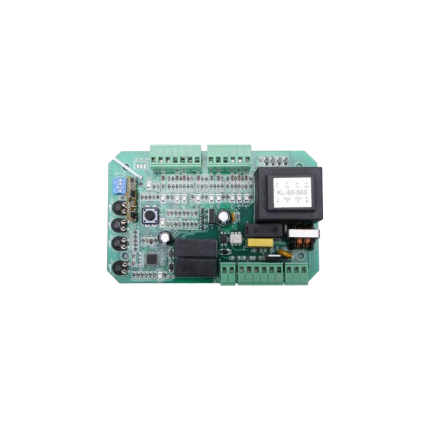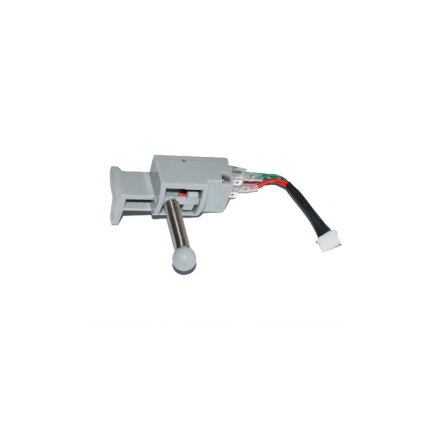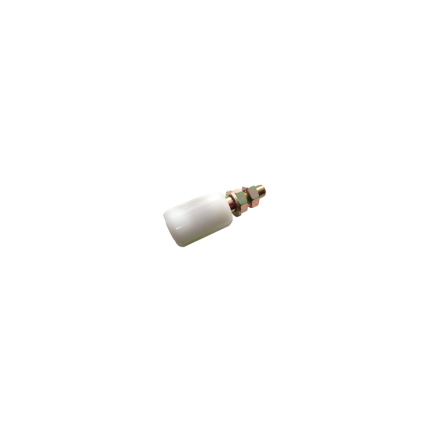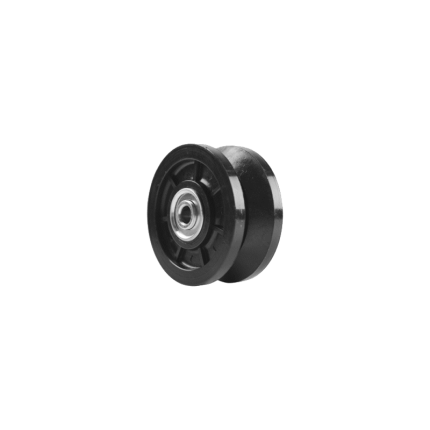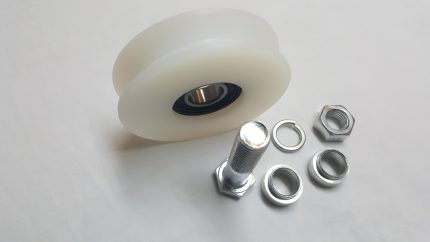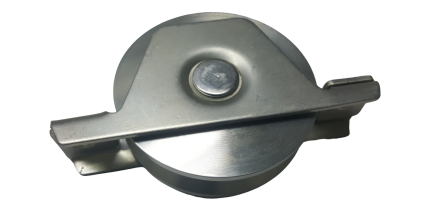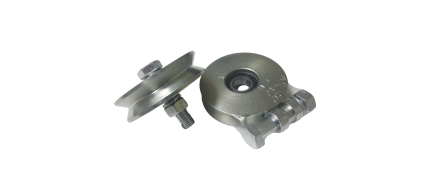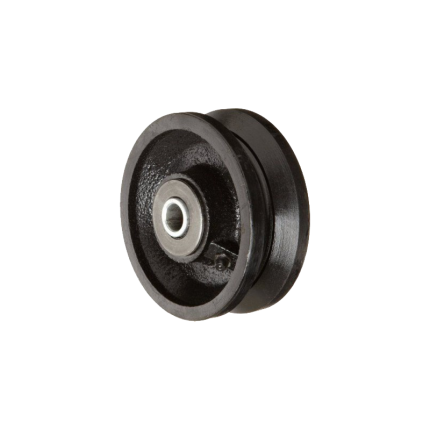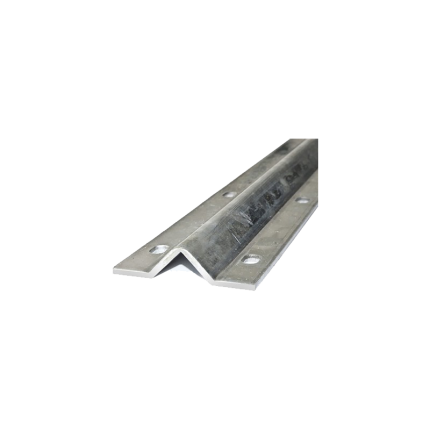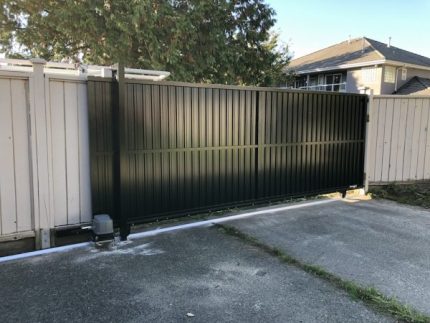Shop
Sliding gate operator main control board – VDS
Ship or pick up from our office.
Sliding gate operator main control board – VDS
The VDS SIMPLY sliding gate operator's main control board is the central unit that controls the operation of a sliding gate, typically one that weighs up to 600kg.
It's made by VDS Automation, an Italian company known for its gate automation products.
This control board manages functions like opening and closing the gate, potentially adjusting speed and force, and integrating with accessories such as keypads and safety sensors.
-
Central Control:The control board acts as the brain of the gate, receiving signals from remote controls or other input devices and translating them into actions for the gate's motor and other components.
-
Remote Control Integration:It typically includes a built-in radio receiver that can be programmed to work with VDS remote controls.
-
Safety Features:The control board can manage safety mechanisms like anti-squashing systems and potentially adjustable speed and force settings.
-
Easy Installation and Programming:The VDS SIMPLY control board is designed for easy installation, often featuring pre-wired components and straightforward programming.
-
Optional Accessories:It can be integrated with optional accessories like keypads, safety sensors, and other components to enhance functionality.
-
Durability:The control unit is often housed in a box with an air-stop seal to protect it from moisture and insects, and the mechanical parts may be lubricated with lithium grease for longevity.
-
Italian Manufacturing:VDS (Simply SL110) is specifically mentioned as an Italian-made control board, emphasizing quality and reliability.
Sliding gate operator main control board – Zero
Ship or pick up from our office.
Sliding gate operator main control board – Zero
The sliding gate operator main control board (also referred to as a PCB or circuit board) is the central component that manages all the functions of an automatic sliding gate system.
It acts as the "brain" of the gate, receiving signals from various input devices (like remote controls, keypads, or safety sensors) and translating them into actions for the gate's motor and other components.
Here's a more detailed breakdown:
1. Central Control: The control board is the central hub for all gate operations. It receives signals from different sources, such as:
- Remote controls: For opening and closing the gate.
- Keypads: For authorized access.
- Safety sensors: To detect obstructions and prevent accidents.
- Other accessories: Such as loop detectors, intercom systems, etc.
2. Signal Processing: The control board interprets the signals it receives and determines the appropriate action for the gate.
3. Motor Activation: Based on the processed signal, the control board sends instructions to the gate's motor to either open or close the gate.
4. Adjustable Settings: The control board often allows for adjustments to various parameters, including:
- Gate speed: The speed at which the gate opens and closes.
- Opening and closing timers: To control the duration of the gate's movement.
- Safety features: Including force adjustments, obstacle detection sensitivity, and slow-down settings.
Sliding gate operators limit sensor -Spring
Ship or pick up from our office.
Sliding gate operator limit sensor -Spring
A sliding gate operator limit sensor with a spring mechanism (also known as a mechanical limit switch or spring limit switch) is a common type of sensor used in automatic sliding gate systems to define the gate's fully open and fully closed positions. Here's how it works and what its characteristics are: Purpose of a Limit Sensor: For any automatic gate operator, the system needs to know exactly when the gate has reached its desired open and closed positions. This is crucial for:- Stopping the Motor: Preventing the motor from continuing to run once the gate has reached its limit, which would otherwise cause damage to the gate, the motor, or the track.
- Safety: Ensuring the gate stops precisely where it should, preventing it from hitting obstacles or over-extending.
- Proper Operation: Allowing for features like auto-closing, pedestrian mode, and proper synchronization if it's a dual-gate system.
- Components: A spring limit switch typically consists of:
- A microswitch (an electrical switch that requires very little force to operate).
- A spring-loaded lever, arm, or plunger connected to the microswitch.
- A mounting bracket to attach it to the gate operator or gate frame.
- Mounting: The spring limit switch is usually positioned on the gate operator itself, or on a bracket near the motor.
- Interaction with the Gate:
- On the sliding gate itself, usually along the gear rack or a specific part of the gate frame, two small "stop" tabs or flags are installed – one for the open limit and one for the close limit.
- As the gate moves towards its fully open or fully closed position, one of these tabs/flags will physically contact and push against the spring-loaded lever/plunger of the limit switch.
- This physical contact compresses the spring and activates the microswitch.
- Signal to Control Board: When the microswitch is activated, it sends an electrical signal to the gate operator's main control board.
- Motor Stop: Upon receiving this signal, the control board immediately cuts power to the motor, stopping the gate precisely at that determined limit.
- Physical Contact: The defining feature is that it relies on direct physical contact and force to activate the switch.
- Reliability: Generally reliable as they are a simple mechanical system.
- Durability: Made to withstand repeated physical contact. However, over time, the spring can wear out, lose tension, or the switch itself can be damaged by repeated impacts or debris.
- Adjustability: The position of the "stop" tabs on the gate can be adjusted to fine-tune the exact open and closed positions of the gate.
- Maintenance: May require periodic checks to ensure the spring is intact, the switch is clean, and the "stop" tabs are securely in place and correctly positioned. They can be susceptible to damage from impacts (e.g., if a child's toy or a pet gets in the way of the stop tab).
- Compared to Magnetic Limit Switches:
- Magnetic Limit Switches: These are more common in newer and higher-end gate operators (like many BFT Deimos "Ultra" models). They use magnets attached to the gate and magnetic sensors (reed switches or Hall effect sensors) on the operator. They offer a "contactless" operation, which generally leads to less wear and tear, greater precision, and less susceptibility to environmental debris or physical impact damage.
- Spring/Mechanical Limit Switches: Are typically more cost-effective and simpler in design. They are still widely used, especially in more budget-friendly or older gate operator models.
Sliding gate support roller
Ship or pick up from our office.
Sliding gate support roller
Sliding gate roller guides are essential components of sliding gates that facilitate smooth and controlled movement along a track or rail.
They help the gate stay aligned, preventing it from wobbling or coming off the track during operation. These guides are typically comprised of a bracket (often L-shaped) and one or more rollers, often made of nylon, that minimize friction and ensure quiet, efficient gate movement.
Key functions of sliding gate roller guides:
-
Smooth & Stable Movement:They ensure the gate slides smoothly along the track, preventing jerky movements and noise.
-
Alignment & Stability:They keep the gate aligned with the track, preventing it from wobbling or falling off.
-
Reduced Friction:The rollers minimize friction between the gate and the track, improving the gate's efficiency and lifespan.
-
Enhanced Durability:By reducing friction and stress on the gate and its components, they contribute to the longevity of the entire system.
Types of Sliding Gate Roller Guides:
-
L-Shaped Bracket with Rollers:This is a common type, featuring an L-shaped bracket that can be mounted on a post and nylon rollers that guide the gate.
-
Cantilever Gate Rollers:Specifically designed for cantilever gates (those that don't require a bottom track), these rollers provide support and smooth movement.
-
Adjustable Rollers:Some guides allow for horizontal adjustment of the roller position to accommodate different gate widths.
-
Flat Mount Wheels:Used when there's no need for a wheel cutout, these screw directly onto the bottom rail of the gate.
Materials and Construction:
-
Rollers:Typically made of nylon or other durable materials that can withstand wear and tear.
-
Brackets:Often made of steel (galvanized or stainless steel) for strength and durability.
Applications:
Sliding driveway gates, Security gates, Garden gates, Barn doors, Garage doors, Sheds, and Storage spaces.
In essence, sliding gate roller guides are critical for the proper functioning and longevity of sliding gates, ensuring smooth, reliable, and quiet operation.
Sliding gate V-Groove nylon wheels -SLGWN778MLB
Sliding gate V-Groove nylon wheels -SLGWNS250
Ship or pick up from our office.
*Double bearing *Max 250 Kg *98 mm Diameter (4") x 44 mm Width (1-3/4") (Heavy-duty bolts, nuts, and washers are included)Sliding gate V-Groove wheels – SLGWSD410EB
Ship or pick up from our office.
Sliding gate V-Groove wheels - SLGWSD410EB
*Steel material *Double bearing *Exterior Bracket *Max 410 Kg *98 mm Diameter x 36 mm Width *Heavy-dutySliding gate V-Groove wheels – SLGWSD410IB
Ship or pick up from our office.
Sliding gate V-Groove wheels - SLGWSD410IB
*Heavy-duty *Steel material *Double bearing *Interior Bracket *Max 410 Kg *98 mm Diameter x 33 mm WidthA sliding gate V-groove wheel is a type of wheel designed to roll along a V-shaped track, providing support and guidance for sliding gates, particularly those made of metal.
The V-groove in the wheel precisely matches the track, ensuring smooth, stable, and quiet operation. These wheels are often used in industrial and heavy-duty applications due to their ability to handle significant weight and resist wear.
Here's a more detailed explanation:
-
V-Groove Design:The defining feature of these wheels is the V-shaped groove on their circumference. This groove fits snugly onto a corresponding V-shaped track, which can be made of angle iron or other suitable materials.
-
Track System:The track is typically installed along the path where the gate will slide, providing a stable and guided surface for the wheels to roll on.
-
Benefits:V-groove wheels offer several advantages, including:
- Smooth Operation: The close fit between the wheel and track minimizes friction and vibration, resulting in smooth gate movement.
- Stability: The V-groove design provides excellent stability, preventing the gate from wobbling or derailing.
- Durability: Many V-groove wheels are made from durable materials like steel or nylon, offering good wear resistance and longevity.
- Load Capacity: They can handle substantial weight, making them suitable for heavy gates.
- Smooth Operation: The close fit between the wheel and track minimizes friction and vibration, resulting in smooth gate movement.
-
Applications:V-groove wheels are commonly used in:
- Industrial Gates: Supporting heavy doors in factories and warehouses.
- Heavy-Duty Sliding Gates: For residential and commercial properties.
- Automated Gates: Used in conjunction with gate operators.
- Other Sliding Applications: They can also be found in other applications like sliding machinery or even pet gates.
- Industrial Gates: Supporting heavy doors in factories and warehouses.
-
Materials:V-groove wheels can be made from various materials, including:
- Steel: Offers high strength and load capacity.
- Nylon: Provides good wear resistance and reduced noise.
- Polyurethane: Offers a good balance of durability and quiet operation.
- Steel: Offers high strength and load capacity.
-
Installation:The wheels are typically mounted to the bottom of the gate, allowing them to roll along the track.
Sliding gate V-Groove wheels – SLGWSS400
Ship or pick up from our office.
Sliding gate V-Groove wheels - SLGWSS400
*Heavy-duty *Steel material *Single bearing *Max 400 Kg *98 mm Diameter x 32 mm Width *Heavy-duty bolts, nuts, and washers are includedSliding gate V-groove wheels are designed to roll along a V-shaped track, providing a guided and stable rolling surface for sliding gates.
These wheels are crucial for the smooth operation of sliding gates, especially those made of metal or used in industrial settings. The V-groove design minimizes friction, reduces noise and vibration, and ensures the gate remains aligned with its track.
Here's a more detailed explanation:
-
Function:V-groove wheels are specifically designed to roll along a V-shaped track, which can be made of angle iron or other suitable materials. This design provides guidance and support for the gate, preventing it from deviating from its intended path.
-
Benefits:The V-groove design offers several advantages:
- Reduced Friction: The angled surface of the groove allows the wheel to roll smoothly, minimizing friction and making it easier to open and close the gate.
- Noise Reduction: The smooth rolling action reduces noise and vibration compared to other wheel designs.
- Stability: The V-groove ensures the gate remains aligned with the track, preventing it from wobbling or derailing.
- Load Capacity: V-groove wheels are often designed with heavy-duty construction to handle substantial weight, making them suitable for various gate sizes and materials.
- Reduced Friction: The angled surface of the groove allows the wheel to roll smoothly, minimizing friction and making it easier to open and close the gate.
-
Materials:V-groove wheels are available in different materials, including:
- Nylon: Offers good wear resistance, low friction, and resistance to various environmental conditions.
- Steel: Provides strength and durability, suitable for heavy-duty applications.
- Cast Iron: Another durable option, often used for industrial applications.
- Nylon: Offers good wear resistance, low friction, and resistance to various environmental conditions.
-
Applications:V-groove wheels are used in a wide range of sliding gate applications, including:
- Residential Gates: For driveways and other entryways.
- Commercial Gates: In businesses and industrial settings.
- Industrial Doors: In factories and warehouses.
- Residential Gates: For driveways and other entryways.
Sliding gate V-Groove wheels -SLGWS800
Ship or pick up from our office.
Sliding gate V-Groove wheels -SLGWS800
Sliding gate V-Groove wheels are a fundamental component in a common type of sliding gate system. Unlike cantilever gates that hang above the ground, these gates roll directly on a track installed on the ground. Here's a detailed explanation: What they are: A V-Groove wheel is a type of wheel specifically designed with a V-shaped groove machined into its circumference. This groove perfectly mates with a corresponding V-shaped track, which is usually made of angle iron or a similar steel profile. How they work:- Track Installation: A V-shaped steel track is securely laid and typically anchored into the driveway or ground along the entire length of the gate's travel path. This track acts as the "railroad track" for the gate.
- Wheel Attachment: The V-Groove wheels are attached to the bottom frame of the sliding gate. Depending on the gate's length and weight, multiple wheels will be strategically placed along its underside.
- Guidance and Support: As the gate opens or closes (either manually or with a gate opener), the V-shaped groove of the wheels sits snugly onto the V-shaped track. This tight fit ensures:
- Smooth and Stable Movement: The gate rolls smoothly and without wobbling or derailing.
- Guidance: The wheels effectively guide the gate in a straight line, preventing it from veering off course.
- Load Distribution: The wheels bear the weight of the gate, distributing it evenly along the track.
- Materials: V-Groove wheels are typically made from durable materials to withstand heavy loads and wear:
- Steel (most common): Offers high strength, load capacity, and durability. Often zinc-plated or galvanized for corrosion resistance.
- Cast Iron: More economical but can be more prone to breakage than steel, and may require more frequent lubrication.
- Nylon or High-Impact Polymer: Quieter in operation and excellent for corrosion resistance, but generally have lower load capacities than steel and may not last as long under heavy use.
- Bearings: High-quality V-Groove wheels incorporate sealed bearings (like precision ball bearings). These reduce friction, ensure smooth rolling, and often require no lubrication, making them "maintenance-free."
- Sizes: Available in various diameters (e.g., 3", 4", 6") and load capacities (ranging from hundreds to thousands of pounds per wheel) to suit different gate sizes and weights.
- With or Without Brackets: Some wheels come with integrated mounting brackets for easier installation, while others are just the wheel itself, requiring a custom bracket or housing.
- Stability and Alignment: The V-groove design provides excellent stability, keeping the gate perfectly aligned with the track and preventing it from tilting or derailing.
- High Load Capacity: Especially steel V-Groove wheels, they are designed to handle very heavy gates, making them suitable for large residential, commercial, and industrial applications.
- Durability and Longevity: Made from robust materials, they offer a long service life, particularly with sealed bearings.
- Relatively Simple System: The concept is straightforward, and the components are widely available.
- Ground Track Maintenance: The main drawback compared to cantilever gates is that the ground track can accumulate debris (leaves, dirt, snow, ice). This debris must be regularly cleaned to ensure smooth operation and prevent damage to the wheels or opener. In Surrey, BC's climate, this is an important consideration due to rain and potential for snow.
- Driveway Disruption: Installing a ground track requires cutting into or modifying the driveway surface.
- Noise: While smoother than some other wheel types, they can still produce some noise, particularly if the track is not perfectly clean or if the wheels are worn.
Sliding Gate V-Track
Ship or pick up from our office.
Sliding Gate V-Track
NOTE: For 25 ft sliding gate V-Track, please do not make an online order.Because of the limit of the shipping length and weight, we have to cut the full length of the product (25') to 2 x (12'-6") for pick-up from our store OR 4 x (6'-3") to send by Canada Post.
If your order requires cutting services, additional costs will apply.
To create an order for sliding gate V-Track, please send your request with the shipping address, postal code, and the length of your inquiry in the note. You will receive a quotation with the shipping costs within a maximum of one business day. A sliding gate V-track is a specific type of ground track that a sliding gate rolls on, utilizing wheels with a complementary V-shaped groove. This system is one of the most common ways to implement a sliding driveway gate, especially for residential and light commercial applications. Here's a breakdown: Purpose: The sliding gate V-track as the linear guide and support for the entire sliding gate. It ensures that the gate moves in a straight line, smoothly, and without wobbling or derailing as it opens and closes. It's an integral part of a "rolling gate" system, where the gate literally rolls on the ground. Key Characteristics and Components:- V-Shape Profile: The most defining feature. The track has an inverted V-shape or a 90-degree angle (like an angle iron) with a slightly rounded top. This V-shape mates perfectly with the V-groove wheels attached to the bottom of the gate.
- Materials:
- Galvanized Steel (Most Common): Highly durable, strong, and resistant to corrosion due to the galvanization process. It can handle heavy gates and high traffic volumes. Sections are typically joined together to form the required length.
- Aluminum: Lighter weight and excellent corrosion resistance. Often used for lighter gates or in environments where rust is a major concern (like coastal areas).
- Installation:
- Bolt-Down: The V-track is typically designed to be bolted securely to a concrete driveway or foundation. It has pre-drilled holes for anchor bolts. This allows for easier installation on existing concrete and simpler replacement if a section gets damaged.
- Embeddable (Less Common for DIY): Some V-tracks are designed to be embedded directly into wet concrete during construction.
- Level and Straight: Crucially, the V-track must be installed perfectly level and straight along the entire travel path of the gate to ensure smooth and consistent operation. Any dips, humps, or curves will cause issues with the gate's movement and can put undue strain on the gate operator and wheels.
- Lengths: Sliding gate V-tracks are sold in sections (e.g., 6 feet, 10 feet, 2.4 meters, 3 meters). Multiple sections are joined together using connection pins or by welding to achieve the total required length, which should be at least twice the width of the gate opening to allow the gate to fully retract.
- Complementary Hardware:
- V-Groove Wheels: These are essential and roll directly on top of the V-track. As discussed previously, they have a V-shaped groove that fits snugly into the track.
- Guide Rollers/Posts: Used at the top of the gate to keep it upright and prevent tipping.
- Gate Stops: Installed at the ends of the track to prevent the gate from over-traveling.
- Stability: The sliding gate V-track V-groove design provides excellent lateral stability, keeping the gate aligned and preventing it from wobbling.
- Load Capacity: Due to the direct ground support and robust V-track/wheel combination, these systems can handle very heavy and long gates.
- Simple Mechanical Principle: The system is straightforward, making it reliable.
- Debris Accumulation: The main drawback is that the V-track, being on the ground, is susceptible to collecting dirt, leaves, gravel, snow, and ice. This debris can obstruct the gate's movement, cause wear on the wheels, and may even lead to derailment or damage to the gate opener. Regular cleaning of the track is essential, especially during winter months in Canada.
- Driveway Disruption: Installing a sliding gate V-track requires modifying the driveway surface, often by bolting it down or embedding it in concrete, which creates a slight raised profile.
- Water Drainage: Proper drainage around the track is important to prevent water pooling.
Sliding gate, Full Privacy, 12 ft
Pick up from our showroom at #100, 11538 132A Street, Surrey, BC.
Sliding gate, Full Privacy, 12 ft
- Aluminum Full Privacy Sliding Gate
- Sliding Gate Package Includes: 1 x driveway gate panel, 2 x steel gate posts (8' H by 4" x 4" each), Rollers, Wheels, V-tracks
- Material: Aluminum Tube Framing, Aluminum privacy panels with a black powder paint coating
- Sliding Gate Dimensions: 12' W x 6' H.
- No hidden fees
A sliding gate is a type of gate that opens and closes by moving horizontally along a track, typically along a fence line.
Unlike swing gates, which rotate on hinges, sliding gates save space, making them ideal for narrow driveways or areas with limited space. They are commonly used in residential, commercial, and industrial settings for security and access control.
Here's a more detailed explanation:
How it works:
-
Track and Wheels:Sliding gates typically move along a track, either embedded in the ground or mounted along the fence line. They are supported by wheels or rollers that run along the track.
-
Mechanism:The gate is usually opened and closed by a motor and gear system that engages with a toothed rack on the gate, causing it to slide.
-
Space Saving:The horizontal movement allows sliding gates to operate in areas where swing gates wouldn't be feasible due to space constraints.
-
Security:Sliding gates offer a robust security solution, especially when combined with access control systems.
-
Types:Common types include traditional sliding gates, which use a track, and cantilever gates, which don't require a ground track and are supported by a counterbalance system.
-
Benefits:They are known for their space-saving design, ease of installation (especially cantilever gates), and minimal maintenance.


